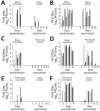Effect of Prior Influenza A(H1N1)pdm09 Virus Infection on Pathogenesis and Transmission of Human Influenza A(H5N1) Clade 2.3.4.4b Virus in Ferret Model
- PMID: 40023783
- PMCID: PMC11878296
- DOI: 10.3201/eid3103.241489
Effect of Prior Influenza A(H1N1)pdm09 Virus Infection on Pathogenesis and Transmission of Human Influenza A(H5N1) Clade 2.3.4.4b Virus in Ferret Model
Abstract
Reports of human infections with influenza A(H5N1) clade 2.3.4.4b viruses associated with outbreaks in dairy cows in the United States underscore the need to assess the potential cross-protection conferred by existing influenza immunity. We serologically evaluated ferrets previously infected with an influenza A(H1N1)pdm09 virus for cross-reactive antibodies and then challenged 3 months later with either highly pathogenic H5N1 clade 2.3.4.4b or low pathogenicity H7N9 virus. Our results showed that prior influenza A(H1N1)pdm09 virus infection more effectively reduced the replication and transmission of the H5N1 virus than did the H7N9 virus, a finding supported by the presence of group 1 hemagglutinin stalk and N1 neuraminidase antibodies in preimmune ferrets. Our findings suggest that prior influenza A(H1N1)pdm09 virus infection may confer some level of protection against influenza A(H5N1) clade 2.3.4.4.b virus.
Keywords: A(H5N1); Influenza A virus; clade 2.3.4.4b; ferrets; influenza; pathogenesis; prior infection; respiratory infections; transmission; viruses; zoonoses.
Figures



References
-
- US Department of Agriculture. HPAI confirmed cases in livestock [cited 2024 Aug 30]. https://www.aphis.usda.gov/livestock-poultry-disease/avian/avian-influen...
MeSH terms
Substances
LinkOut - more resources
Full Text Sources
Medical

